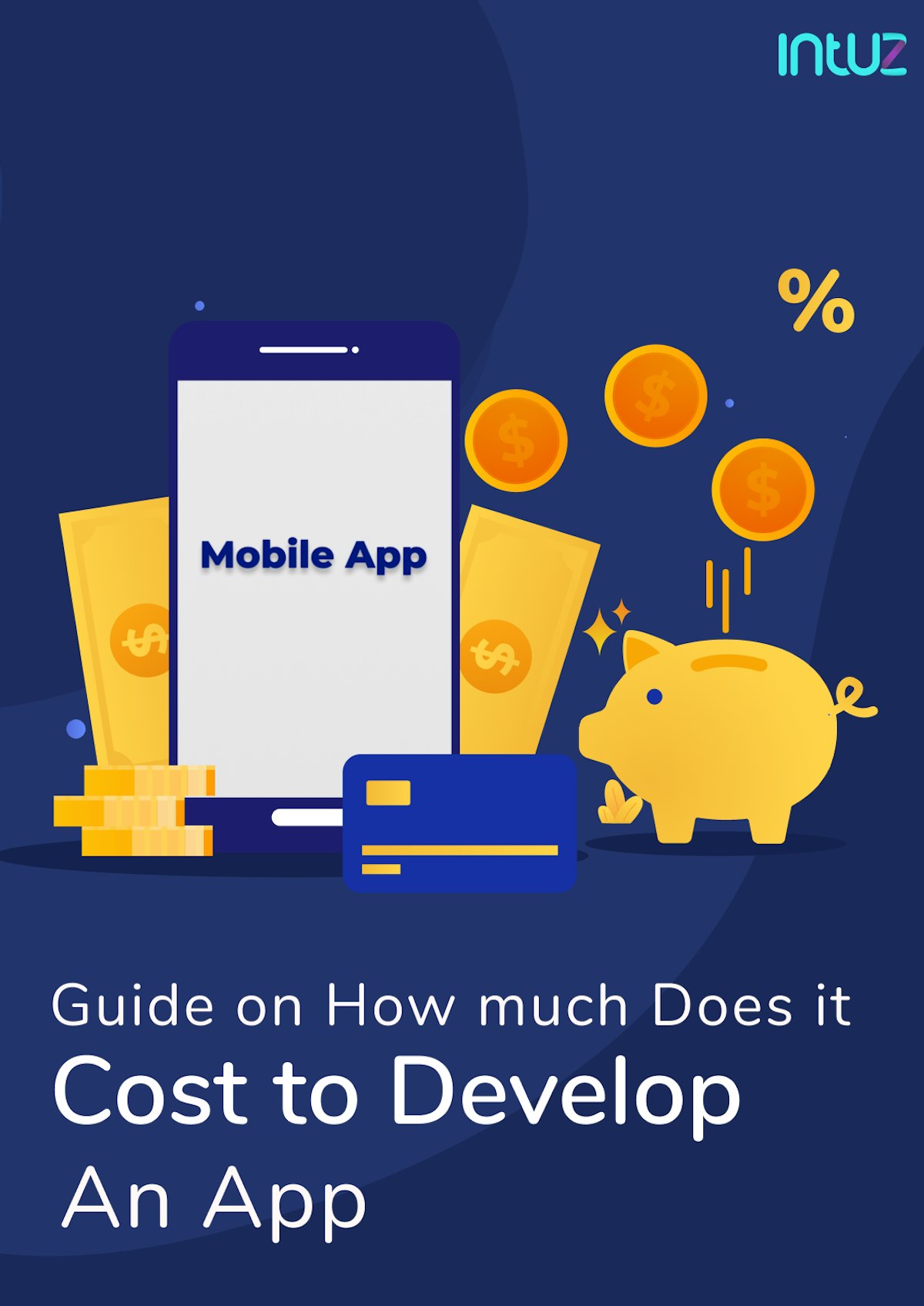With a surge in technological advances, marketing strategies have shifted from traditional approaches—TVs, prints, and billboards—to digital. Just like other marketing brands, mobile app marketing companies utilize internet-based channels to spread advertising messages and create awareness about their mobile apps.
The mobile app industry is a very saturated space. According to Market Research Future, over 65% of business and big brands already own a mobile app. Building a mobile app is one thing; launching it in the market and getting users to install, actively use, and share your mobile app is entirely a new and problematic task.
The following are guidelines for successfully launching your app on the app store.
Table of content
Step-by-Step Mobile App Marketing Guide
1. Understand Your Target Audience
At the core of a mobile app is the consumer. The consumer is the user of your mobile app. Before mobile app development, pick your audience and understand them. Issues such as who is going to use your mobile app and how they are going to benefit from your app must be addressed beforehand.
Prior identification and understanding of your target audience provide you with a roadmap in developing your mobile app’s functionalities and layout according to their needs and preferences. Besides, this also gives you a chance to structure your mobile app promotion strategies, which will eventually save you time and app marketing costs.
The target audience can be defined according to various factors such as their age, gender, spending, and recreational habits. For example, gaming app developers usually target youths, and e-learning app developers focus on academia. Behavioral characteristics are also used to define a target audience; for example, a recipe mobile app developer can target individuals who attend cooking classes or follow cooking blogs.
2. Research Your Competitors
Apart from understanding your audience, take time to know and understand your competitors. Competitors are mobile applications that exist in your area of interest—they serve a similar purpose, and they target the same audience as your app.
Understand what your competitors are doing and what is working for them, but most importantly, understand what they have done and what isn’t working for them. This kind of understanding provides you with a blueprint on how to model your mobile app and marketing strategy.
Nothing will ruin your mobile app marketing technique more than being considered an imitator with a monotonous marketing strategy and product. Still, with a better understanding of your competitor apps, you get a rare chance of structuring a unique and improved mobile application marketing plan that distinguishes it from the others.
Some notable aspects to understand in competitor analysis are strengths, weaknesses, and opportunities. Strengths involve things that make the marketing strategy stand out and why the audience prefers it over a similar approach. Weaknesses include a lack of availability of the marketing strategy or their app product on specific platforms. Through your competitor’s strengths and weaknesses, you define your opportunity channels.
3. Do Early Mobile App Marketing
If you already developed your mobile app, and are now trying to come up with a marketing strategy, then there is bad news for you, As you are a bit late, and you worked your way backward. A marketing strategy is built and deployed before the mobile app is readily available.
Just as much as there's a reason movie producers release movie trailers before releasing a complete movie, marketing strategies should also be created to lead up to actual app development for a simple reason - anticipation! Anticipation sells, or better still, anticipation creates hype and curiosity; it also creates awareness about your app. Early marketing can be done before or during app development, but not after development.
Early marketing may include the deployment of videos briefly describing your app’s development schedule or running surveys and opinion polls on features and functionalities app users might want to be built into the app. As the app development nears its end, you can incorporate your app’s teasers to the app marketing campaigns.
4. Prepare a Press Kit
As much as the new age app marketing platform—social media—is taking over, traditional platforms like TVs and prints are still beneficial. Their effectiveness comes from the fact that they command a huge follower base, and not all app users are on social media. This is where press kits come in.
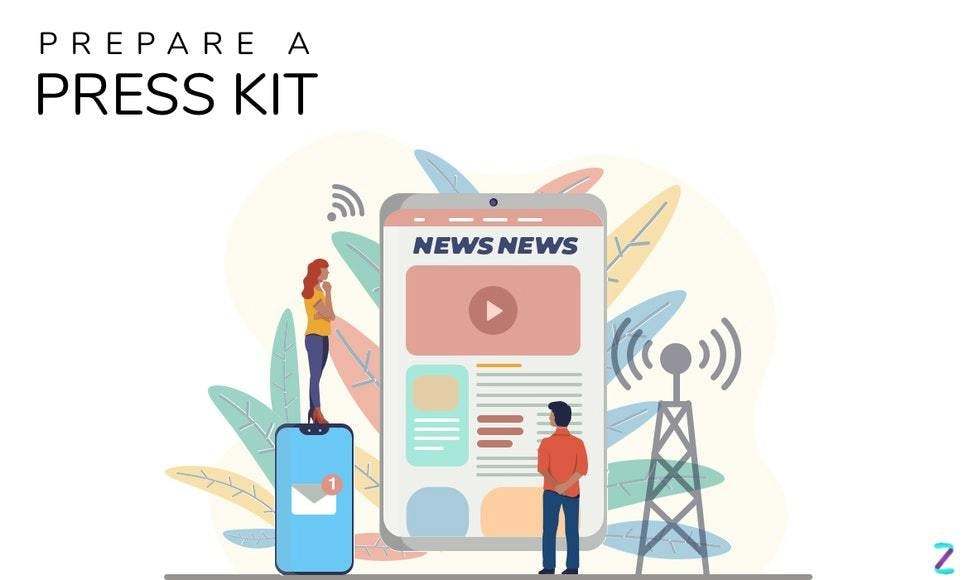
Depending on your app marketing budget, there are two kinds of press releases you can do: pre-launch and official launch app releases. Pre-launch release happens just before the launch of the app. This is where you introduce your app, but you should pay more attention to giving reasons why app users ought to look forward to it.
Imagine having your press release ad running at prime time when millions are glued to TV screens, or having a print media dedicate a whole page to your app press release. Also, there are professional app marketing agencies or organizations running promotions, reaching out to these groups is another advisable practice. They offer custom mobile app marketing packages as per your requirements to derive the best app downloads.
Running press releases increases awareness of your product, and at the same time, creates and builds its reputation. Running press releases is one thing: having those releases create an impression is another. You should prepare your press kit beforehand—your press kit should cover the core functionalities of your mobile app—and after that, reach out to your preferable press media and promotion groups.
Some tips to create and deploy an impactful press kit
- Your press release should be clear and straightforward from the outset. Additionally, the title of your press release should clearly state your app’s value.
- Follow and have interaction with relevant media personalities and bloggers on social media. Furthermore, use platforms like Cision to find relevant journalists likely to cover your app.
- Include a manual guide that outlines your app's notable features and how the app works. Also, to grab attention and create an impression, include clear screenshots of your app in action.
An ultimate guide on adopting agile marketing methodology
Take a Tour5. Optimize Your App’s Page on App Stores
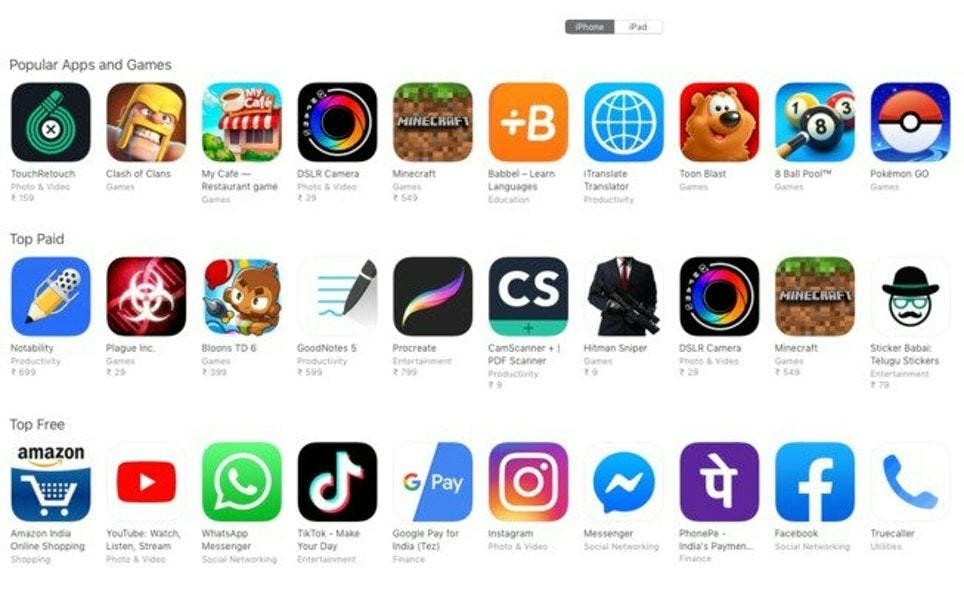
More than 50% of downloaded apps are discovered through browsing in the app store. An app store carries thousands of applications; many of them serve the same purpose. As with a website representing the kind of products and services in your store, your app’s layout also represents how content-wise rich it is.
Whereas the app store is the ground zero of your app’s availability, it’s also an ecosystem of stiff competition due to thousands of available apps. For example, for every one game-related app, there exist hundreds or thousands of similar apps. For these reasons, you need to do app store optimization to stand out in the competition on the app store.
Some of the App Optimization Aspects:
- App Title—You should make your app’s title short, readable, and recognizable.
- App Description—Make a short description that points out what your app does. In addition, make sure to add screenshots and short videos to describe more about your app.
- App Icon/logo and category—Put up a unique and stand-out app menu. Also, ensure that you have your app placed in the right category for easier search.
- Your title and descriptions should contain keywords with high traffic.
6. Prepare a Mobile App Demo or Promo Video
If you think about it, humans are generally visual creatures. Anything we can visualize stays longer in our memory. That’s the reason why videos are the most consumed content. The chances are that your target audience has no much idea about your mobile app. The best practice of creating awareness about your product, therefore, is to create a video describing your product.
Your video should be concise, imaginative, and highly descriptive. The funnier the video, the better it is since having funny videos for mobile app marketing campaigns is exceptionally captivating. Your video shouldn’t only be uploaded to your website or inside your app, but you should also have it in all and all over social media platforms.
Here are ways you can make your promo video useful:
- The use of animated characters or celebrities will surely grab the attention of your target audience.
- You can capture a live recording of your mobile application while in use.
- The overall appearance of your video should be clear and smooth.
7. Incorporate App Reviews and Ratings
App stores have become a jungle of applications; some are amazing; some are sub-standard, while others are just junk. It’s due to this reality that app consumers have become cautious about the apps they download. A consumer wants to be assured that the app is worthy of use, and what better way of getting that assurance than from a fellow consumer. These assurances come in-form of reviews.
Therefore, you ought to incorporate customer reviews of your app in its social media accounts and website. As long as you intend to put out a functional app, reviews are very beneficial. Reviews create transparency and build trust. Reviews also enable you, the owner, to learn of your app’s strengths and weaknesses; and ways to improve on those weaknesses.
How to get the reviews for your app:
- Build pop-up prompts or messages to encourage your app's user to give a review. Pop-ups are generally not pleasant, but they are effective.
- Personally reach out to users through emails, phone calls, or personal outreach and try persuading them to give you reviews about your app.
- Organize outreach in different forums and platforms through things like contests, and encourage participants to leave reviews.
- Incentivize the reviewers; for example, if it’s a gaming app, you could reward points for reviewing.
- And most importantly, take the reviews provided and make good use of them—find ways to address the negative reviews.
In addition to reviews from actual users, you can reach out to websites that review mobile apps professionally. Some of the notable website reviewers are TechCrunch, ProductHunt, Mashable, and AppAdvice.
8. Build Your App’s Online Presence
Hiring an app developers, building an app, deploying it to the app store, and subjecting it to endorsements and advertisements is not enough; it shouldn’t be enough; you’ve to expand its online presence to other internet platforms. Because, no matter how amazing your app is, there are app users who have never heard of it or are seeking more information about it. This is where your app’s website and social media accounts come in.
Furthermore, when it comes to creating your app awareness, paid advertisements can only take you so far; your app’s website and social media presence helps build on the existing popularity by providing a platform that links your app with its users. An app’s website and social media accounts act as its home, or rather its primary source, where mobile app enthusiasts can learn and engage more about the app.
Your app’s website should be as informative as it can be, while its social media accounts should be very active and engaging. Use keywords in your website and social media posts, as this increases its availability through search.
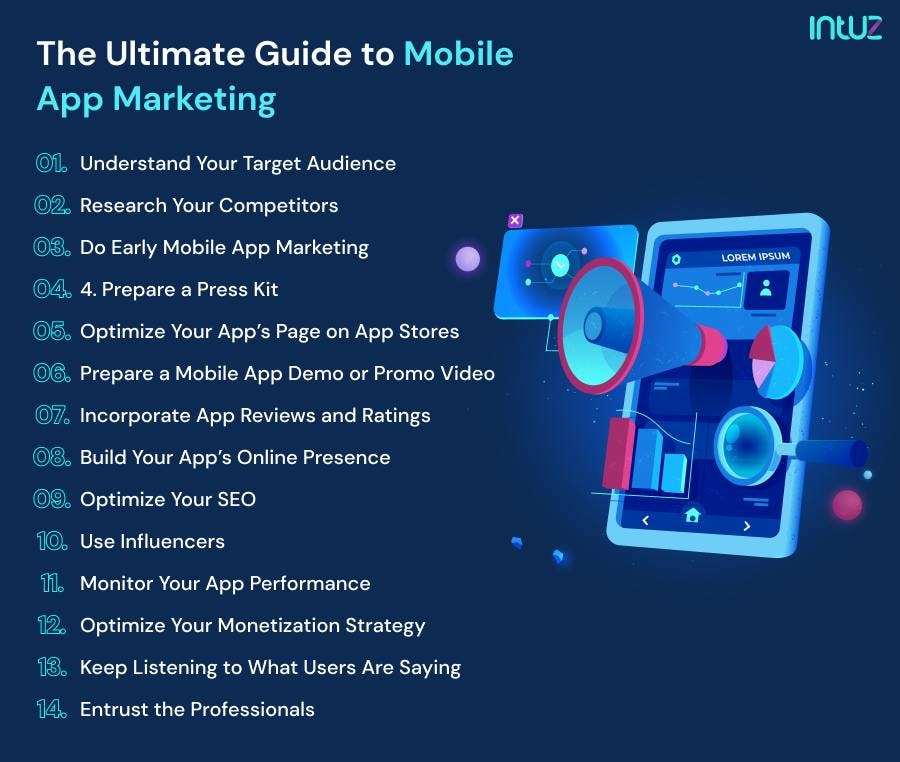
9. Optimize Your SEO
Here’s how a typical mobile app user goes about finding and installing an app; they go over to the app store or website, hit the search box, and key in a word or topic of interest to them. For example, for a gaming user looking to play puzzles, they search for the word "puzzle." All the applications with the keyword "puzzle" pop up. That’s how search engines work; they go through a pile of keywords and return the parent entity of those keywords.
For your application to, therefore, pop up in a search query, you need to develop a rock-solid SEO strategy. SEO involves using keywords in your app’s title and descriptions; and not any other keywords, but those that command high traffic. For example, streaming and live streaming are synonymous terms as far as entertainment apps are concerned, but the word “live streaming” attracts more traffic in search queries.
A good SEO strategy is the one developed way before the launch of a product—60 days is reasonable enough. This is because search engines usually take time to pick and rank new content. Not sure the right keywords to use? It’s simple, head over to UberSuggest Tool and key in words you think best describe your app. The tool will provide you with your keyword statistics, including traffic volume.
10. Use Influencers
Influencer marketing and endorsement is the norm in the current marketing strategies; it acts as the traditional personality endorsements. According to Comboapp, 33% of app consumers say that they have once in a while downloaded an app due to recommendations from a social media influencer they follow. Therefore, rather than following up and down your favorite musician or athlete to endorse your app, you get a famous YouTuber or Twitter bigwig to promote it.
Social media influencers have a large population of online followers who look up to them and trust their opinions. An endorsement post from these influencers reaches and is picked up by thousands of their followers, which they, in turn, share out to their followers too. Eventually, your product endorsement will have been picked by millions of online and offline users, even users on other social media platforms.
For example, a recommendation or promotion can be in the form of a YouTube video prepared and shared by the influencer, a blog post, tweet, or an Instagram post.
Best practices for influencer marketing
- Make sure the influencer is fit or relevant for your product, the influencer also should have a significant number of your target audience.
- Offer benefits to your influencers and their followers; for example, exclusive access and discounts.
11. Monitor Your App Performance
Once you’ve launched and deployed your app to the market, that doesn’t mean your app marketing strategy is over, no…but it just got a bit easier. Now you can sit and monitor how your application is received, and most importantly, the kind of reviews coming in. Key Performance Indicator (KPI) defines metrics you should monitor to gauge the performance of your application.
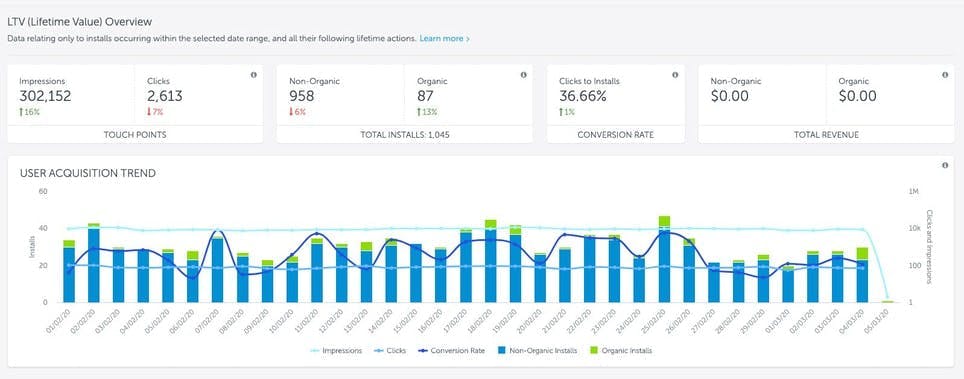
KPIs to monitor your app performance
Some of the common key performance indicators you should monitor to gain insights on the performance of your applications are:
- App downloads—App downloads indicates the number of times your application has been downloaded. Whenever a user downloads your application, the operation is captured, numbered, and stored. Your app is doing okay if the download number is consistently growing, and if otherwise, your marketing strategy may not be working, or maybe your application is not much worthy.
- Active users—This metric indicates the number of users who are actively using your application. The number of active users tells the degree of interest users have in your app. Active users can be categorized into Daily Active Users (DAUs)—active users in a day—and Monthly Active Users (MAU)—active users in a month. Stickiness—the probability of turning MAU to DAU—can be computed from active user metrics.
- Daily session per DAU—As the name suggests, this metric determines the number of times a daily active user uses your application in a day.
- Retention—The retention metric monitors the number of customers who return to your app after their first visit. For example, divide the number of customers who were active this week by the number of those who were active the previous week; the result is your app’s retention rate.
- Churn rate—This is a percentage of customers who stopped using your app. It is calculated from the retention rate.
Some of the best KPI tools are; Datapine, Scoro, InetSoft, and Tableau.
12. Optimize Your Monetization Strategy
After successfully deploying your application to the market, and fixing every bug that might have come up during the review, you want to start earning money. App monetization involves how the app user base can be leveraged into a way of making money from their use.
The following are app monetization strategies you can employ.
- Paid apps—This is the oldest app monetization strategy where a user is charged upfront for downloading an app, with the app store taking its percentage from the cost. Back in the day, there were no technological tools to leverage app advertisements and in-app purchases, so paid apps were the norm. iOS app store was the leading platform for paid apps. With technological advances and with the rise of free apps, paid apps has somehow lost its market.
As much as paid apps have lost their leading position, it’s still useful, especially in cases where the app is of high value. For example, according to Sensor Tower Store Intelligence, Nintendo has generated more than $60 million since the launch of Super Mario Run paid-app in 2016.
If you decide to go with a paid-app approach, make sure to research how your competitors go about it and how they charge.
- In-app advertising—Of all the app monetization strategies, this is the most common and useful. This is what drives the tremendous growth in mobile advertisements; it’s estimated that global mobile advertisement was $180 billion in 2018. This is a huge opportunity for an in-app ad.
With in-app advertising, user downloads and installs an app for free but has to watch or read and advertising posts running on the app from time to time. The app owners earn money by selling ad space to advertising companies. Video and display ads are the most lucrative types of advertisements with the in-app ad. - In-app purchase—If you decide not to charge users during download, you can charge them during use. This monetization strategy involves the separation of your app's basic and advanced features, according to users. You allow users to download and use the app for free, but they have to purchase the app, or rather pay for them to access the advanced features of the app.
In-app purchases are the core revenue channels for game applications. Mortal Kombat X Mobile is one of the top game apps that employ in-app purchases. Here, players use real money to buy characters and equipment.
Google and Apple stores take a 30% cut from each in-app purchase app in their stores.
13. Keep Listening to What Users Are Saying
Mobile app marketing does not end with the successful deployment of the app to the market; you need to pay much attention to what your app users have to say as time goes by. According to a Google study on app usage, the main reasons why app users stop using applications are due to lack of interest, change of usage habits or the app loses value. It’s paramount, therefore, to always engage your app users on their views about your app.
Keep in touch with your audiences:
Some of the ways to keep in touch with your users are as follows:
- Social media—I know we have talked of opening social media accounts dedicated to your app but what we have not talked about is the need for you to populate those accounts with a campaign and promotional posts addressed to your app. Push your app campaigns through trending hashtags and topics. A Twitter survey found out that 82% of Twitter users watch Twitter videos. Therefore, use multimedia—videos, images, and audios—to push your campaigns. Other social media practices you can employ include making live campaign videos and utilizing ephemeral content.
One can run multiple universal and mobile App Installation campaigns for both Android and iOS mobile applications on social media like Facebook and Instagram to increase the app downloads. Then, further can run the app engagement campaigns to connect them throughout. - Push notifications—Push notifications are app notifications that pop up in your
home or notification screen. They form a big part in product promotion, and they usually are opened more often. To keep users interested, your push notification should: - Be Brief and captivating; consider using videos, audios, and pictures. Each push notification should also have new and unique content
- Be segmented according to your users. This ensures the right message reaches the correct user.
Your social media engagements and structuring of your push notifications should be modeled in a way that they solicit reviews and opinions from app users about the overall performance of your application. Take those reviews and build on them. Various app marketing case studies have pointed out the relationship between solicitation of review to the success of app marketing plans.
14. Entrust the Professionals
Mobile app marketing is not easy, especially due to the fact that the app development industry is saturated to the core—when you head over to the app stores and do a simple search, you’re met with hundreds of similar products.
But when all is said and done, you have to structure your application marketing plans in a way that will bump up your app to the top of the list. Concentrate on these three marketing tools: advertising, sales promotion, and direct marketing. The above app marketing strategies, therefore, provides you with a guideline on ways you can create and increase your app’s awareness.
You can always reach out to us for professional app marketing services if you prefer outsourcing your app marketing endeavors. A good mobile app marketing agency specializes in everything mentioned above and provides the best quality services to market your apps.
Mobile App Marketing FAQs
What are the best strategies to promote mobile apps?
There are abundant ways through which one can do mobile app marketing which includes but not limited to app store optimization, social media paid app promotion campaigns, influencer marketing, pre-launch app marketing, pay per click ads on several platforms including play store and app store, in-app advertisements, post download app engagement campaigns and many more.
What is included in the app store optimization service?
App store optimization involves competitor analysis, short tail and long tail keyword research, app title and description optimization, keyword string for iOS apps, app images optimization, app video creation, app Icon optimization etc.
Why should I hire App store Optimization Company to market mobile app?
App’s page SEO matters the most and it is the foremost step to market an app. Well-researched content optimization and marketing mix tactics applied by experts can help organizations to drive more audiences and sales. Moreover, it also reduces the operational cost, helps in gaining quick results. Above all, the app promotion task is tougher than mobile app development and thus, a professional’s keen attention is required.
How much cost does the mobile app marketing agencies charge?
App promotion is a tactful service, it majorly involves two aspects while identifying the cost of the services. One is the advertisement charges like per click rate, etc. charged by specific platforms and other is the service charge for the campaigns developed by the professionals. It depends on the size of the projects, competition rate, complexity of the project and likewise. You can also find mobile app marketing packages here.

